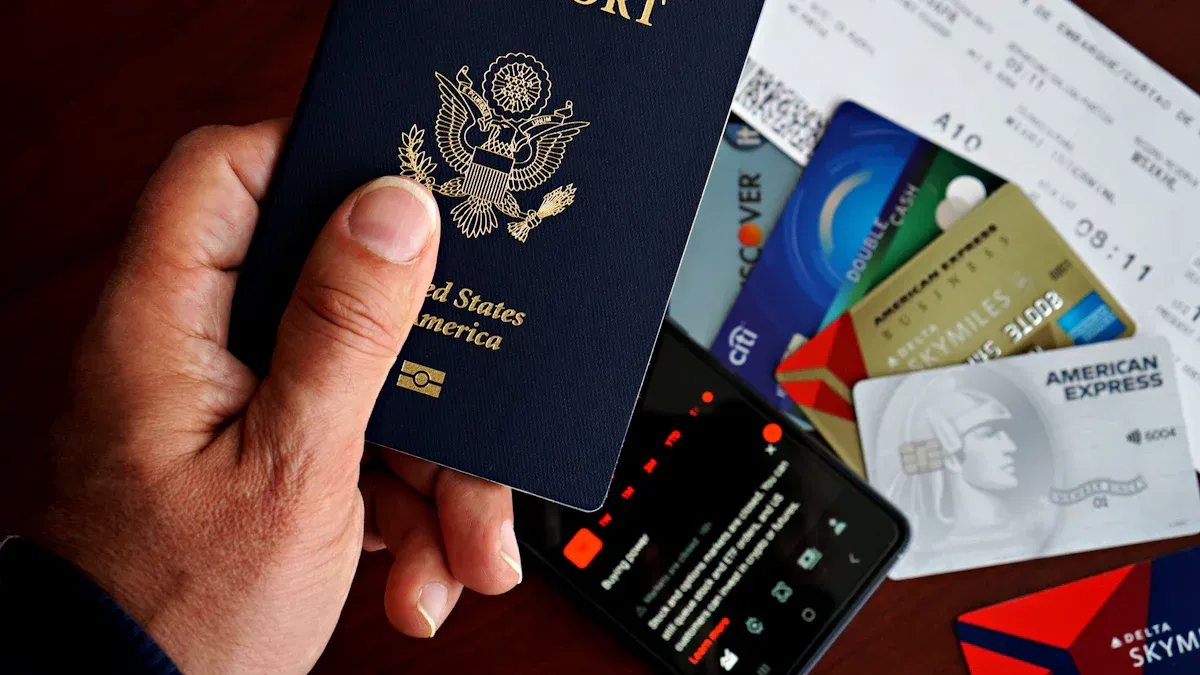- EasyCard
- Trade
- Help
- Announcement
- Academy
- SWIFT Code
- Iban Number
- Referral
- Customer Service
- Blog
- Creator
How to Solve Cross-Border E-Commerce Payment Challenges: A Comprehensive Guide to Mainstream Payment Platforms

Image Source: pexels
Are you troubled by fund recovery challenges in cross-border business? High fees, slow crediting speeds, cumbersome processes, and potential fund security risks are all challenges you must face.
The key to solving these problems is not finding a perfect all-in-one platform. You need to build a cross-border e-commerce payment solution tailored to your business.
The real answer lies in wisely selecting and combining the most suitable payment tools based on your specific needs.
Key Takeaways
- Before choosing a cross-border payment platform, understand where your customers are and their preferred payment methods.
- Payment costs go beyond transaction fees; pay attention to exchange rate spreads, as these impact your profits.
- Fund security is paramount; the chosen platform must comply with international regulations and have robust security technology.
- New sellers should choose easy-to-set-up platforms, growing sellers should optimize costs, and mature sellers should diversify risks.
- There is no best payment platform, only the most suitable combination for your business development stage; adjust flexibly as needed.
Pre-Selection Self-Diagnosis: Four Steps to Clarify Payment Needs
Before diving into comparing platforms, you must clearly understand your own needs. This is like getting an eye exam before fitting glasses; accurate self-diagnosis is the first step to building an efficient, low-cost cross-border e-commerce payment solution.
Examine Target Markets and Payment Habits
Where are your customers? How do they prefer to pay? The answers to these two questions directly determine which payment tools you should prioritize. Payment preferences vary significantly by region.
- European Market: Consumers widely use direct bank transfers, digital wallets, and local payment methods such as iDEAL in the Netherlands and Giropay in Germany.
- North American Market: Credit cards and digital wallets (such as PayPal, Apple Pay) dominate.
- Asian Market: Digital wallets and mobile payments lead, such as Alipay, WeChat Pay, and GrabPay.
The differences between mature and emerging markets are particularly noteworthy. In the UK and North America, over 75% of bank customers handle business online. While in emerging markets like India, many consumers still prefer cash on delivery due to trust or convenience issues. Understanding these habits helps you avoid losing orders due to mismatched payment options.
Calculate Cost Budget and Fee Tolerance
Payment costs go far beyond a single transaction fee. You need to carefully calculate costs hidden in exchange rates. For example, the forex spread is the difference between the buy and sell prices set by banks. If the EUR/USD buy price is 1.1200 USD and the sell price is 1.1250 USD, then $0.0050 is the profit earned by the payment service provider, and your hidden cost.
These fees accumulate quickly:
- Currency conversion fee: Typically 1% to 3% of the transaction amount.
- Foreign transaction fee: Credit card companies and banks may charge up to 3.5% combined.
You must calculate the actual impact of these costs on your profit margin and determine your maximum tolerable fee rate.
Assess Security Compliance and Risk Appetite
Fund security is the lifeline of cross-border business. The platform you choose must strictly comply with international financial regulations, such as anti-money laundering (AML) and know your customer (KYC) rules. These compliance measures protect your funds from fraud and money laundering by verifying customer identities and monitoring suspicious transactions.
The platform’s security technology is equally important. In 2024, Japanese cryptocurrency exchange DMM Bitcoin lost assets worth approximately $305 million USD due to a security breach. This case warns us that choosing a platform with a strong security record and risk control capabilities is critical.
Consider Technical Integration and Operational Convenience
Your payment tools need to seamlessly integrate with your e-commerce website or platform (such as Shopify, WooCommerce). A good payment gateway should offer simple API integration or ready-to-use plugins, allowing you to quickly enable payment functions without complex programming. Mainstream platforms like Stripe and PayPal provide mature integration solutions with major e-commerce systems, greatly simplifying your operations and letting you focus on business growth.
Mainstream Payment Platforms Side-by-Side Comparison: Full Pros and Cons Analysis

Image Source: pexels
After completing self-diagnosis, you have a clear needs map. Now, let’s deeply examine the mainstream payment platforms on the market and test them in your business scenarios. We categorize platforms into three types, analyzing their pros and cons one by one to help you build the most suitable cross-border e-commerce payment solution.
Cross-Border Receiving Accounts: Payoneer, Airwallex, WorldFirst
This type of account is essential for platform sellers. If you sell on Amazon, eBay, Lazada, or other e-commerce platforms, you need such an account to receive platform payouts, manage funds uniformly, and withdraw. Their core function is to provide overseas local bank accounts for low-cost, high-efficiency receipt of foreign currency funds.
- Payoneer: As an industry veteran, Payoneer has the broadest platform support and user base. Its application process is standardized; you only need to prepare personal and contact information, business details, and identity and address proof. For new sellers, this is a very easy-to-use choice.
- Airwallex: A tech-driven fintech company known for highly competitive exchange rates and modern product experience. Its online application process is designed to be intuitive, typically approved within days, ideal for growth-oriented sellers seeking efficiency and low costs.
- WorldFirst: Affiliated with Ant Group, WorldFirst has deep roots and strong brand credibility in mainland China. A key feature is providing dedicated account managers, offering one-on-one professional support when issues arise.
Which has better rates? Fee structures are often the top concern for sellers. Note that some platforms claim “0 fees,” but costs may be hidden in exchange rate spreads.
For intuitive comparison, we’ve compiled the following core fee comparison table:
| Comparison Dimension | Payoneer | Airwallex | WorldFirst |
|---|---|---|---|
| Incoming Fee | Usually free from e-commerce platforms | Free | Free |
| Currency Conversion Fee/Spread | About 2% (VIP down to 1.2%) | Real-time rate + 0.3%~0.6% | Real-time rate + ~0.5% |
| Withdrawal to Bank Fee | ~2% to local bank | Free | Free |
| Account Opening Difficulty | Standardized, complete documents required | Simple, intuitive online process | Simple, local team support |
| Customer Service | 24/7 support | Automated and online support | Dedicated account manager |
Digital Wallets and Payment Gateways: PayPal, Stripe
If your business model is a direct-to-consumer (DTC) independent site, you need a payment gateway that directly faces consumers, handling credit cards and various local payment methods. PayPal and Stripe are the two giants in this field.
Fee Structure Comparison
Stripe is favored by developers and new merchants for its transparent, unified fee structure. In contrast, PayPal’s fee system is more complex, with significant variations by country and transaction type.
Assume a $100 USD order from the U.S., paid via international credit card with currency conversion required; fees are roughly as follows:
| Service | Stripe | PayPal |
|---|---|---|
| International Card Payment | Base rate + 1.5% | 4.4% + fixed fee |
| Currency Conversion Fee | Additional +1% | Additional +4.0% |
| Total Fee for $100 USD Transaction (approx.) | $4.70 USD | $4.89 USD (excluding conversion fee) |
Disputes and Chargebacks
Chargebacks are an unavoidable risk for independent site sellers. When a customer disputes a transaction, not only is the principal revoked, but the platform also charges a non-refundable dispute handling fee.
- Stripe: Charges
$15 USDper dispute.- PayPal: Charges
$20 USDper dispute.
Excessive chargebacks not only erode profits but may also increase payment processing rates or lead to account suspension. Therefore, you need robust logistics tracking and customer service processes to reduce disputes at the source.
Security and Compliance
In terms of security, both Stripe and PayPal meet the highest industry standards. They comply with PCI Level 1 Service Provider standards and use AES-256 encryption to protect sensitive data, ensuring transaction and customer information security.
| Platform | Security Features and Fraud Protection |
|---|---|
| Stripe | - PCI Service Provider Level 1 certified- AES-256 encryption for sensitive data- TLS encryption for all data transmission |
| PayPal | - PCI compliant- Protects financial details from being shared with recipients- Offers buyer and seller protection policies |
Direct Bank Connections and Other Options
Besides third-party payment platforms, traditional bank wire transfers (Wire Transfer) are also an option, especially for large B2B transactions or mature enterprises with established overseas banking relationships.
- Advantages: Bank systems offer extremely high security, with funds transferred directly between accounts on a clear path.
- Disadvantages: Fees are typically higher and less transparent, potentially involving multiple charges from remitting banks, intermediary banks, and receiving banks. Crediting is slower, and there may be remittance amount limits.
In recent years, some major banks have actively expanded into cross-border payments. For example, certain Hong Kong-licensed banks have launched digital financial solutions tailored for e-commerce sellers, combining traditional banking security with modern online operational experience. These solutions are usually suitable for large sellers with corporate accounts and high transaction volumes at the bank.
Build the Optimal Cross-Border E-Commerce Payment Solution

Image Source: pexels
With theoretical knowledge complete, it’s time to combine them into practical strategies suited to your business development stage. An excellent cross-border e-commerce payment solution is not static; it evolves with your business growth.
New Sellers: Quick-Start Solution
As a new seller, your primary goal is to quickly validate products and markets to get your business running smoothly. Therefore, prioritize payment tools that are easy to set up, integrate, and offer a smooth user experience, even if fees aren’t the lowest.
For independent site sellers, especially those using platforms like Shopify, quick startup is critical. An embedded, convenient payment flow can significantly boost order conversion rates.
Here are several quick-start solution comparisons for new independent sites (using the U.S. market as an example):
| Payment Solution | Setup Convenience | Cost (for new stores) | Applicable Market | Notes |
|---|---|---|---|---|
| Shopify Payments | Simple, activate directly in backend | No extra transaction fees, starts at $29 USD/month | USA | Simplifies order process, boosts conversion |
| PayPal | Quick and easy | Higher transaction fees, but free service options | USA | Excellent customer support, available in nearly all Shopify plans |
| Stripe | Easy to implement | Fixed rates, accepts various credit cards | USA | Popular with U.S. merchants, strong international transaction handling |
Growing Sellers: Cost-Optimization Solution
When your monthly sales grow steadily, transaction costs and exchange rate losses become significant profit drains. At this point, your cross-border e-commerce payment solution should shift toward cost optimization. Introducing multi-currency accounts like Airwallex or WorldFirst is a key step.
Multi-currency accounts can significantly reduce costs:
- You can hold multiple foreign currencies in the account, avoiding forced conversions per transaction.
- When you need to convert, you get rates close to interbank market rates.
- You can use received foreign currency directly to pay overseas suppliers or marketing expenses, eliminating unnecessary conversion steps.
This way, you bypass high conversion fees of traditional bank accounts, keeping more profits.
Mature Sellers: Risk-Diversification Solution
For large-scale, multi-market mature sellers, a single payment channel poses significant potential risks. Account freezes or platform policy changes can fatally disrupt cash flow. Therefore, building a risk-diversified, stable, and reliable payment matrix is essential.
Your strategy should be “primary with backup, multi-channel parallel.” For example, use Stripe as the main payment gateway for your independent site, with PayPal as a secondary option to cover different customer payment habits. For payouts from platforms like Amazon, receive through multiple accounts like Payoneer and Airwallex to avoid concentrating funds in one channel, thus establishing a robust, flexible cross-border e-commerce payment solution.
There is no absolute best platform for cross-border e-commerce payments, only the most suitable combination for your current business development stage. Treat payments as a dynamically optimized strategic component, regularly reviewing and adjusting your payment matrix based on market changes and business expansion.
Looking ahead, with the popularization of real-time payment systems, AI-driven solutions, and blockchain technology, cross-border fund flows will become faster, safer, and smarter.
Proactively building and optimizing an efficient, secure payment system lays the strongest foundation for your global business success.
FAQ
Can I directly use a personal bank account for payments?
It is not recommended. Mixing personal and business finances brings compliance risks and complicates account management. You should use accounts specifically set up for e-commerce business to meet anti-money laundering (AML) and know your customer (KYC) regulations, ensuring clear and compliant fund flows.
With so many platforms, which has the lowest fees?
There is no absolute “lowest fee” platform. Total cost depends on your transaction volume, currency types, and business model. You need to comprehensively compare transaction fees, withdrawal fees, and exchange rate spreads. For high-volume sellers, some platforms offer customized preferential rates; proactively inquire.
Do cross-border e-commerce funds need to be taxed in mainland China?
Yes, income from cross-border e-commerce generally needs to be declared and taxed according to relevant laws and regulations in mainland China.
Tax issues are very complex, and policies change frequently. We strongly recommend consulting a professional tax advisor to ensure your business is fully compliant and avoid potential legal risks.
*This article is provided for general information purposes and does not constitute legal, tax or other professional advice from BiyaPay or its subsidiaries and its affiliates, and it is not intended as a substitute for obtaining advice from a financial advisor or any other professional.
We make no representations, warranties or warranties, express or implied, as to the accuracy, completeness or timeliness of the contents of this publication.




Contact Us
Company and Team
BiyaPay Products
Customer Services
is a broker-dealer registered with the U.S. Securities and Exchange Commission (SEC) (No.: 802-127417), member of the Financial Industry Regulatory Authority (FINRA) (CRD: 325027), member of the Securities Investor Protection Corporation (SIPC), and regulated by FINRA and SEC.
registered with the US Financial Crimes Enforcement Network (FinCEN), as a Money Services Business (MSB), registration number: 31000218637349, and regulated by FinCEN.
registered as Financial Service Provider (FSP number: FSP1007221) in New Zealand, and is a member of the Financial Dispute Resolution Scheme, a New Zealand independent dispute resolution service provider.



















